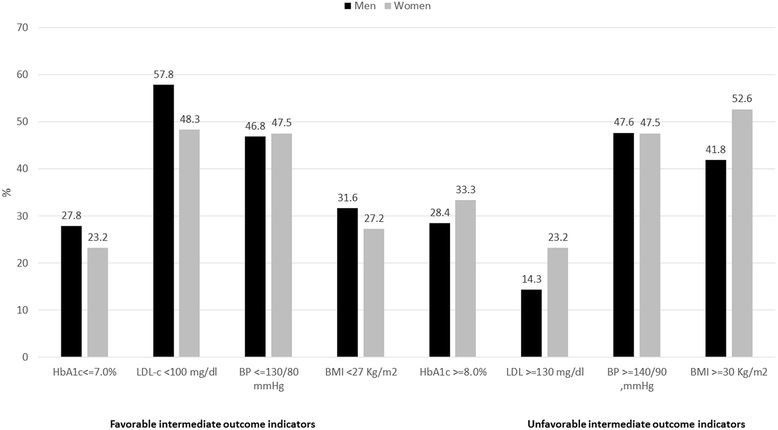The complex interplay between clinical and person-centered diabetes outcomes in the two genders
- PMID: 28222781
- PMCID: PMC5320673
- DOI: 10.1186/s12955-017-0613-0
The complex interplay between clinical and person-centered diabetes outcomes in the two genders
Abstract
Background: New approaches to cope with clinical and psychosocial aspects of type 2 diabetes (T2DM) are needed; gender influences the complex interplay between clinical and non-clinical factors. We used data from the BENCH-D study to assess gender-differences in terms of clinical and person-centered measures in T2DM.
Methods: Clinical quality of care indicators relative to control of HbA1c, lipid profile, blood pressure, and BMI were derived from electronic medical records. Ten self-administered validated questionnaires (SF-12 Health Survey; WHO-5 well-being index; Problem Areas in Diabetes (PAID) 5, Health Care Climate Questionnaire, Patients Assessment of Chronic Illness Care, Diabetes Empowerment Scale, Diabetes Self-care Activities, Global Satisfaction for Diabetes Treatment, Barriers to Taking Medications, Perceived Social Support) were adopted as person-centered outcomes indicators.
Results: Overall, 26 diabetes clinics enrolled 2,335 people (men: 59.7%; women: 40.3%). Lower percentages of women reached HbA1c levels < =7.0% (23.2% vs. 27.8%; p = 0.03), LDL-cholesterol < 100 mg/dl (48.3 vs. 57.8%; p = 0.0005), and BMI <27 Kg/m2 (27.2 vs. 31.6%; p = 0.04) than men. Women had statistically significant poorer scores for physical functioning, psychological well-being, self-care activities dedicated to physical activities, empowerment, diabetes-related distress, satisfaction with treatment, barriers to medication taking, satisfaction with access to chronic care and healthcare communication, and perceived social support than men; 24.8% of women and 8.8% of men had WHO-5 < =28 (likely depression) (p < 0.0001); 67.7% of women and 55.1% of men had PAID-5 > 40 (high levels of diabetes-related distress) (p < 0.0001). At multivariate analysis, factors associated with an increased likelihood of having elevated HbA1c levels (≥8.0%) were different in men and women, e.g. having PAID-5 levels >40 was associated with a higher likelihood of HbA1c ≥8.0% in women (OR = 1.15; 95%CI 1.05-1.25) but not in men (OR = 1.00; 95%CI 0.93-1.08).
Conclusions: In T2DM, women show poorer clinical and person-centered outcomes indicators than men. Diabetes-related distress plays a role as a correlate of metabolic control in women but not in men. The study provides new information about the interplay between clinical and person-centered indicators in men and women which may guide further improvements in diabetes education and support programs.
Keywords: Diabetes-related distress; Gender-disparities; Psychological wellbeing; Type 2 diabetes.
Figures
References
Publication types
MeSH terms
LinkOut - more resources
Full Text Sources
Other Literature Sources
Medical



